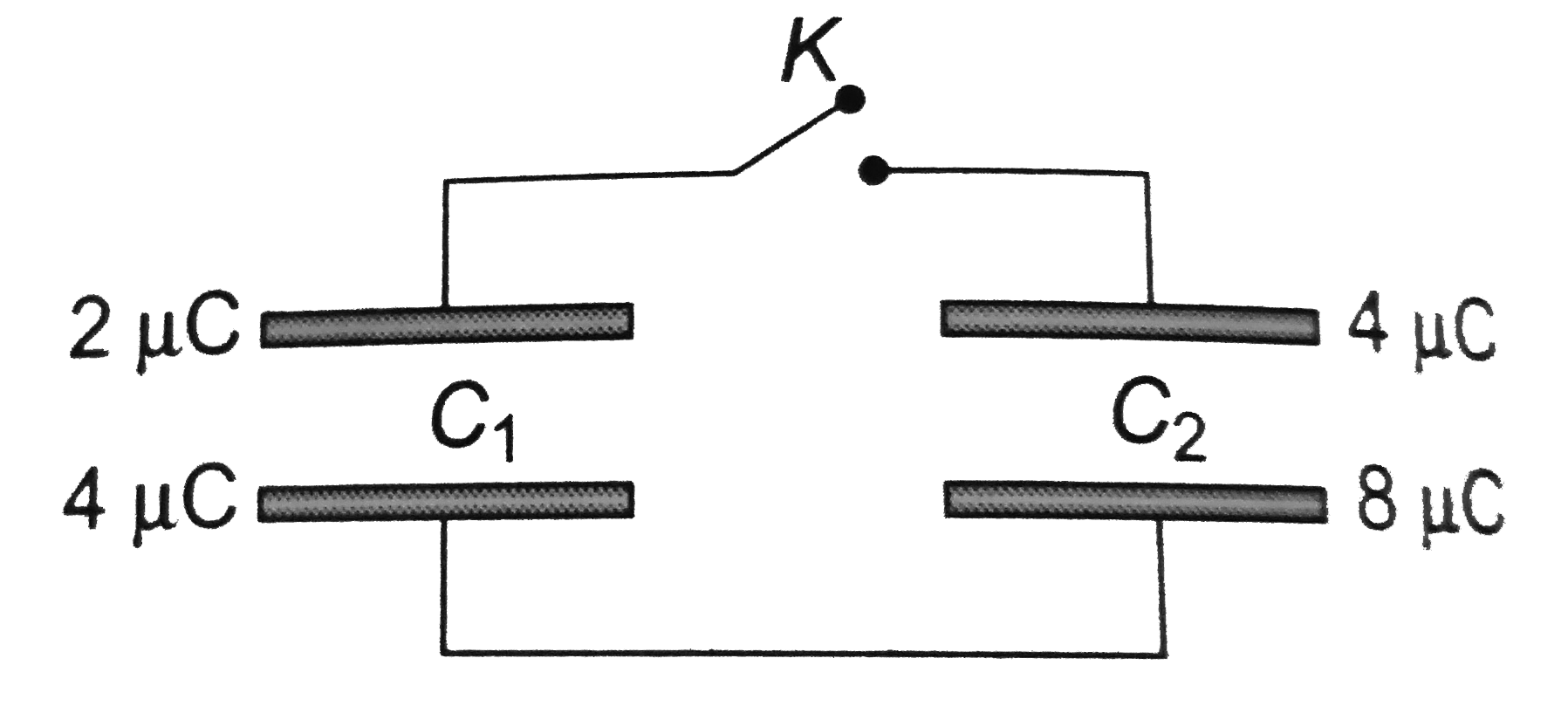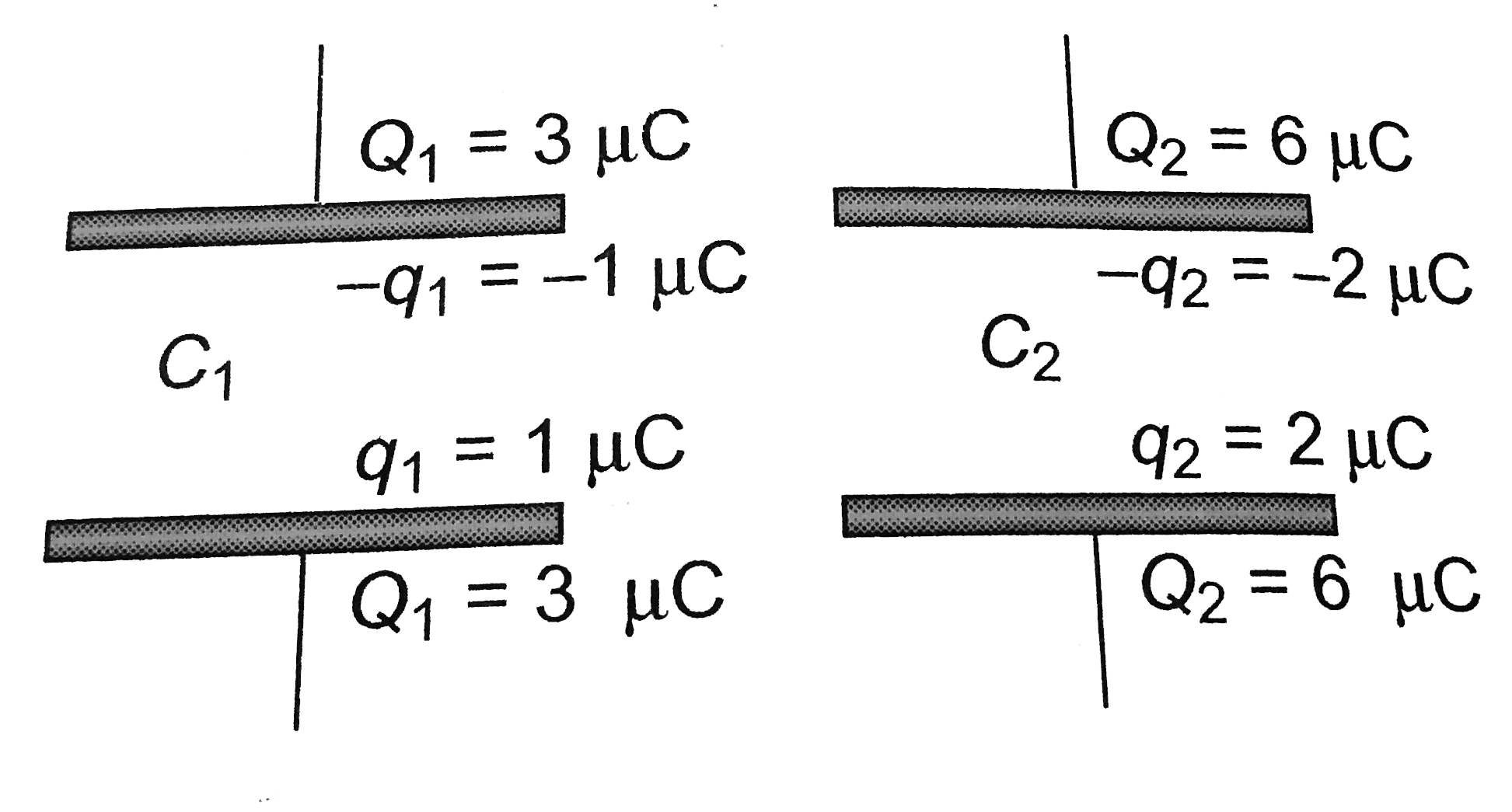Assertion: Charges are given to plates of two plane parallel plate capacitors C1 and C2 (such that C2=2C1) as shown in figure. Then the key K is pressed to complate the circuit. Finally the net charge on upper plate and net charge on lower plate of capacitor C1 is positive.

Reason: In a parallel plate capacitor both plates always carry equal and opposite charge.
If both assertion and reason are true and reson is the correct explanation of assertion.
If both assertion and reason are true but reason is not the correct explanation of assertion.
If assertion is true but reason is false.
If assertion and reason both are false.
The correct Answer is:C
In isolated condition the charge distribution on each surface of capacitor C1 and C2 is

The p.d. across first capacitor is q1C1=1μFC1
The p.d across second capacitor is q2C2=2μFC2
Hence potential difference across both the capacitors is same (hence C2=2C1). therefore on connecting both capacitors, charges, charge does not flow from one capacitor to other. Therefore net charge on upper and lower plates of C1 is positive.
Hence Assertion is true and Reason is false.
Topper's Solved these Questions
- ELECTRIC POTENTIAL & CAPACITANCEBook:A2ZChapter:ELECTRIC POTENTIAL & CAPACITANCEExercise:AIPMTNEET Questions
Explore 38 Videos
- ELECTRIC POTENTIAL & CAPACITANCEBook:A2ZChapter:ELECTRIC POTENTIAL & CAPACITANCEExercise:AIIMS Questions
Explore 20 Videos
- ELECTRIC POTENTIAL & CAPACITANCEBook:A2ZChapter:ELECTRIC POTENTIAL & CAPACITANCEExercise:Problems Based On Mixed Concepts
Explore 44 Videos
- ELECTRIC CHARGE, FIELD & FLUXBook:A2ZChapter:ELECTRIC CHARGE, FIELD & FLUXExercise:Section D - Chapter End Test
Explore 29 Videos
- ELECTROMAGNETIC INDUCTIONBook:A2ZChapter:ELECTROMAGNETIC INDUCTIONExercise:Section D - Chapter End Test
Explore 30 Videos
Similar Questions
Knowledge Check
A parallel plate capacitor is charged. If the plates are pulled apart
Athe potential difference increasesBthe capacitance increasesCthe total charge increasesDthe charge and the potential difference remain the sameIf the plates of a parallel plate capacitor are not equal in area then quantity of charge
AOn the plates will be same but nature of charge will differBOn the plates as will as nature of charge will be differentCOn the plates will be different but nature of charge will be sameDAs well as nature of charge will be sameA parallel plate capacitor C has a charge Q. The actual charges on its plates are
AQ,QBQ/2, Q/2CQ,-QDQ/2. - Q/2
The plates of a parallel plate capacitor are, not exactly parallel. The surface charge density therefore :
View SolutionThe plates of a parallel plate capacitor are, not exactly parallel. The surface charge density therefore :
View SolutionThe electrostatic force between the metal plate of an isolated parallel plate capacitro C having charge Q and area A, is
View SolutionOne plate of parallel plate capacitor is smaller than the other, the charge on the smaller plate will be.
View SolutionIn an isolated parallel plate capacitor of capacitance C the four surfaces have charges Q1,Q2,Q3 and Q4 as shown in the figure. The potential difference between the plates is :

View Solution